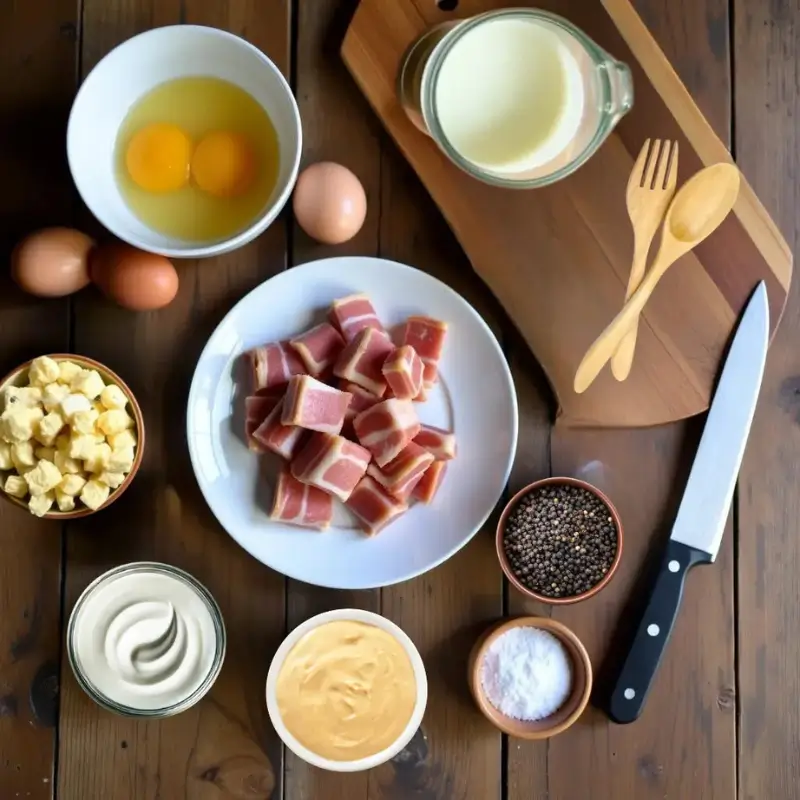Eggs Benedict Casserole is a delightful twist on the classic brunch favorite, bringing together the elegant flavors of traditional Eggs Benedict in a convenient, make-ahead dish. This casserole captures the essence of a leisurely weekend brunch, combining the rich, velvety texture of hollandaise sauce with the comforting, savory layers of English muffins, Canadian bacon, and perfectly baked eggs. It’s an ideal choice for gatherings, allowing you to enjoy the company of your guests without being tied to the stove. With a few expert tips, you can achieve a perfect balance of flavors and textures, ensuring your casserole is a show-stopping centerpiece at your next brunch.
Table of Contents
From Classic Brunch to Casserole Delight
The inspiration for this dish came to me one bustling Sunday morning in the kitchen of a luxury hotel, where I noticed guests gravitating toward the Eggs Benedict station at our brunch buffet. The delicate poached eggs, creamy hollandaise, and savory Canadian bacon on a toasted English muffin was always a favorite. As I observed the joyful chatter and satisfied smiles, I pondered how I might capture this beloved dish in a form that could easily serve a crowd. The answer was a casserole, a concept that marries the sophistication of Eggs Benedict with the practicality of a one-dish meal.
Turning a classic dish into a casserole was not just about convenience; it was about preserving the integrity of its original flavors while enhancing its appeal with new textures and presentation. The challenge was to strike the perfect balance between the creamy, the crispy, and the savory—a culinary puzzle I was eager to solve.
The Art of Layering Flavors
Crafting an Eggs Benedict Casserole is all about layering flavors and textures to create a harmonious dish. It starts with the base—English muffins, toasted to golden perfection. Toasting the muffins not only enhances their flavor but also ensures they hold up under the creamy custard that ties the casserole together. The key is to allow the muffins to soak just enough to be flavorful yet retain their structure.
Next comes the Canadian bacon, offering a salty, savory contrast to the muffins. For those seeking a twist, consider using smoked salmon or even prosciutto for a different depth of flavor. The eggs, the heart of the dish, are gently cracked over the layers, providing rich, silky yolks that meld seamlessly into the casserole.
Hollandaise: The Casserole’s Crown
One cannot discuss Eggs Benedict without paying homage to its crowning glory: the hollandaise sauce. This luscious, buttery emulsion is what elevates the casserole from ordinary to extraordinary. Making hollandaise can be intimidating, but with a few tricks, it becomes an achievable task. Use a blender to create a smooth, stable emulsion, and don’t skimp on the quality of your butter; it makes all the difference.
My secret to infusing the sauce with a touch of elegance is a subtle hint of lemon zest, which brightens the flavors without overpowering them. The hollandaise is drizzled generously over the casserole just before serving, ensuring each bite is a luxurious experience.
Customization and Creativity
While the classic ingredients form the backbone of this dish, there’s ample room for creativity. Consider adding sautéed spinach or asparagus for a touch of green and a hint of earthiness. For a spicier kick, a few dashes of hot sauce in the hollandaise can awaken the palate. Cheese lovers might sprinkle gruyere or cheddar between the layers for added richness.
This casserole is as versatile as it is delicious, accommodating a variety of taste preferences and dietary considerations. It’s a testament to the adaptability of a dish that has transcended its roots to become a universal favorite.
A Culinary Evolution
Throughout my culinary journey, the Eggs Benedict Casserole has evolved, reflecting the diverse tastes of the diners I’ve had the pleasure of serving. Each iteration has taught me something new about balancing flavors and understanding the nuances of texture. It’s a dish that never fails to impress, whether served at a casual family gathering or a sophisticated brunch soirée.
As you embark on crafting your own Eggs Benedict Casserole, remember that cooking is an art, and every recipe is a canvas. Experiment, adapt, and make it your own, knowing that this luxurious dish will always be a crowd-pleaser. And as you savor the fruits of your labor, invite others to join you in this culinary celebration, sharing in the joy of good food and good company.
Eggs Benedict Casserole: Best 5 Tips for Perfect Results
Description
This creamy, savory casserole combines classic eggs Benedict flavors in an easy-to-prepare dish. Perfect for brunch gatherings or a special breakfast.
Ingredients
For the Casserole
For the Hollandaise Sauce
Instructions
Prepare the Ingredients
-
Gather and Prepare
Start by gathering all your ingredients: English muffins, Canadian bacon, eggs, milk, heavy cream, Dijon mustard, salt, and freshly ground black pepper. Dice the English muffins into bite-sized pieces and cut the Canadian bacon into small chunks.Using day-old muffins can help achieve a better texture, as they absorb the egg mixture more effectively.
Assemble the Casserole
-
Layer and Arrange
In a greased baking dish, create a layer with half of the diced English muffins, followed by a layer of half the Canadian bacon. Repeat this process to form a second layer.
Ensure the layers are even to allow for consistent baking and flavor distribution.
Prepare the Egg Mixture
-
Whisk the Eggs
In a large mixing bowl, whisk together the eggs, milk, heavy cream, Dijon mustard, salt, and pepper until fully combined and slightly frothy.The Dijon mustard adds a subtle tang that enhances the overall flavor profile.
Combine and Chill
-
Pour and Soak
Pour the egg mixture evenly over the layers in the baking dish, ensuring all the bread pieces are well soaked. Cover the dish with plastic wrap and refrigerate for at least 2 hours, or overnight for best results.Allowing the casserole to sit overnight not only saves time in the morning but also enhances the flavors as they meld together.
Bake to Perfection
-
Bake and Finish
Preheat your oven to 375°F (190°C). Remove the plastic wrap and bake the casserole in the preheated oven for 45-50 minutes, or until the top is golden brown and the eggs are set.Let the casserole rest for a few minutes before serving to allow the flavors to settle.
Serve and Enjoy
-
Garnish and Serve
For a finishing touch, garnish with chopped fresh chives or parsley before serving. Enjoy your elegant Eggs Benedict Casserole with a side of fresh fruit or a light salad.For an extra touch of luxury, consider serving with a drizzle of hollandaise sauce.
Nutrition Facts
Nutrition Facts
Servings 8
Serving Size 1
- Amount Per Serving
- Calories 529.83kcal
- % Daily Value *
- Total Fat 33.08g51%
- Saturated Fat 16g80%
- Trans Fat 0.08g
- Cholesterol 288.5mg97%
- Sodium 579.33mg25%
- Potassium 327.5mg10%
- Total Carbohydrate 27.6g10%
- Dietary Fiber 1.07g5%
- Sugars 6.02g
- Protein 26.5g53%
- Vitamin A 465.83 IU
- Vitamin C 0.45 mg
- Calcium 117.83 mg
- Iron 1.5 mg
- Vitamin D 47.5 IU
- Vitamin E 0.37 IU
- Vitamin K 0.25 mcg
* Percent Daily Values are based on a 2,000 calorie diet. Your daily value may be higher or lower depending on your calorie needs.
Note
1. Opt for a crusty, artisan-style bread, such as a sourdough or country loaf, to provide a sturdy base that soaks up the custard without becoming too soggy. Cut the bread into uniform cubes to ensure even baking and a consistent texture throughout the casserole.
2. When preparing the hollandaise sauce, patience is key. Use a double boiler to gently whisk the egg yolks, lemon juice, and butter over low heat. This will prevent the sauce from curdling, resulting in a smooth, velvety finish. For an extra hint of depth, consider adding a touch of cayenne or smoked paprika.
3. Poaching the eggs separately before incorporating them into the casserole ensures they remain perfectly runny. Use a gentle simmer and a splash of vinegar in the water to help the whites set beautifully. Once poached, transfer them quickly to an ice bath to halt cooking, maintaining that luscious yolk.
4. Layer your ingredients thoughtfully. Begin with a base of bread cubes, followed by a generous scattering of Canadian bacon or smoked ham. This ensures every bite captures the harmony of flavors. Pour the egg mixture evenly over the top, pressing gently to allow the bread to absorb the custard fully.
5. Allow the casserole to rest before serving. This crucial resting period, akin to letting a roast settle, allows the flavors to meld and the textures to firm up, making slicing and serving a breeze. A final flourish of freshly chopped chives or parsley adds a burst of color and freshness to the dish.











